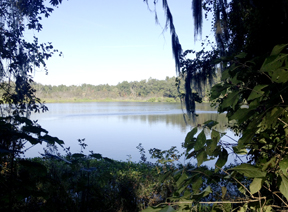Civilization seems distant after a hike to Itchy Bottom Lake in the San Felasco Hammock Preserve State Park, yet less than a mile away resides Progress Corporate Park, home to some of Alachua County’s fastest-growing businesses.
This dichotomy within the City of Alachua is a microcosm of the competing priorities that have existed within the county for at least the last 300 years.
The Alachua County Today begins a series profiling county communities with an overview of the county as a whole.
To understand the current context of the land and people and where both may be headed in the future, we begin with an overview of the past.
Alachua County has been populated for at least the last 8,000 years as the natural springs, rivers and bountiful savannahs have long attracted humans.
Yet the contemporary debates that often portray conservation and development as antagonists can be traced back to the first interactions between Europeans and the native peoples of Alachua.
The Spanish established a handful of missions to convert the natives to Christianity in the 17th and 18th Centuries which had the tragic side effect of decimating the population primarily due to disease.
The weakened state of the Spanish Empire in the late 18th and early 19th Centuries combined with the expansionistic tendencies of the young United States contributed to an influx of American pioneer settlers to northern Florida, including the Alachua territory.
Spain ceded Florida to the U.S. in 1819, which soon led to the first established inland settlement in the territory at Micanopy in southern Alachua County in 1821.
The first outright conflict over natural resources occurred in 1835 when growing tensions between American settlers and Seminoles – who were intruding outside the bounds of their reservation due to a scarcity of food – erupted into the Second Seminole War.
The war resulted in the further diminishment of Native American territory and power. Soon after, American settlements adjacent to transportation routes began to increase in prosperity: Newnansville (near the present-day city of Alachua) was the county seat and largest settlement in Alachua County for several decades as it sat on the first federal highway in Florida, the Bellamy Road.
Evolving technology, however, led to evolving settlement patterns and resource usage that left quite a few ghost towns in its wake.
Railroads entered the county in the 1850s, bypassing Newnansville, thus prompting leading residents to create a new town to house the county government located on the Florida Railroad line connecting Fernandina Beach to Cedar Key: Gainesville.
Yet the full boom resulting from railroads was not felt until after the Civil War when lines became more numerous. Cotton and citrus had been major industries, but a series of hard freezes in the 1890s decimated the citrus crop in northern Florida.
Other resources became profitable until exhausted or made obsolete: sawmills became quite common as the lumber industry started booming in the 1880s along with naval stores, turpentine and tobacco in the 1890s. All paled in comparison, though, to the impact the phosphate mining industry would have on the western portion of the county.
The economic boon that would endure above all, however, was Gainesville’s winning bid over Lake City to host the consolidated state schools for higher education as the University of Florida in 1906.
While other industries have waxed and waned, the jobs produced at the university and through university auspices, research, and affiliations continue to abound.
Competing visions of the future for Alachua County continue to focus on its natural resources and are embodied in the quite distinct identities of its communities.
Cities like Alachua tend to seek to attract businesses in order to enhance economic growth, while those like Micanopy and High Springs tend to cater to tourists who come to visit the rivers, springs, and historic sites that some perceive to be threatened by the growing population that could result in part from continued business growth.
Regardless of the causes, Alachua County population growth is in keeping with the rapid trend of Florida in general, having increased from approximately 151,000 people in 1980 to 253,000 in 2013.
A similar issue that faced residents of Alachua County in the past thus continues to be relevant today: at what point, if any, does the opportunity cost of continued growth become too much?
Different interpretations and proposed solutions vary not only from community to community but also from disparate voices within each.
Over the next several weeks we will take a more intimate look at the particular history and character of each of these communities.
# # #
Email dwisener@
alachuatoday.com
Alachua County: In Contrast - Communities in Profile
Tools
Typography
- Font Size
- Default
- Reading Mode


